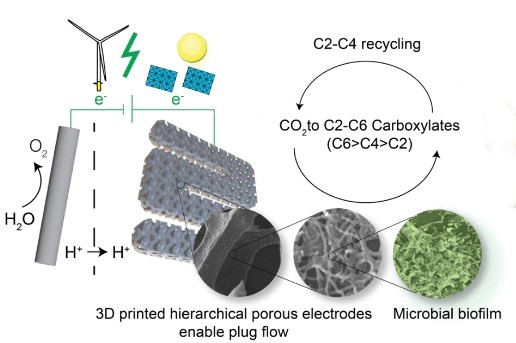UnveiLIN - Unveiling Nonphotochemical Laser Induced Nucleation mechanisms
“To develop a multiscale model for MES reactors. To identify transport limitations and aid in the design and scale up of novel MES reactor concepts. “
In open systems, under appropriate conditions, microorganisms can utilize cheap electrodes as the source of electrons, thus enabling “electrical” upgrading of CO2 by so-called microbial electro-synthesis (MES). A mixture of C2-C4-C6 carboxylates can currently be produced from MES, from which hexanoate (C6) has the most direct industrial and economic promise. Currently, the most fundamental and overarching challenge is to obtain deep understanding of, and overcome, the limiting steps to produce C6 selectively, from microorganism scale to reactor scale, to initiate the scaling up and industrialization of MES as platform technology. To achieve breakthrough understanding of the process-limiting steps, MES will be computationally modeled. Special efforts will be given towards modeling microbial and electrochemical kinetics, pore-scale transport phenomena, and reactor-scale fluid dynamics.
MES is resolved from µm-scale to m-scale, to identify all possible process limitations at the biofilm-scale, electrode-scale, and reactor scale. As usual for such complex systems, it is impossible to capture all scales in a single simulation. Instead, a multiscale approach will be adopted where correlations for effective transport properties, wettability, and effective kinetic parameters, obtained from detailed mesoscale (µm-mm) models, are used in coarse-grained reactor-scale (cm-m) models. These correlations can be tuned and validated using a small set of representative experiments. Such a multiscale approach is essential because, to date, very little is known about carbon, electron, and inorganics fluxes in MES. However, it is of utmost importance to elucidate these fundamental mechanisms at the mesoscale so that strategies can be implemented to overcome any limitations and integrate those strategies to the reactor-scale.
The current objective is to (a) generate correlations for effective pore-averaged transport properties (effective mass transfer rates, effective diffusivities, and conductivities), wettability (gas-liquid saturation) and kinetic parameters. To this end, a detailed model that can predict mesoscale transport phenomena in resolved 3D electrodes and biofilm, inclusive of both electrochemical and microbial kinetics depending on local properties (current density, pH, concentrations, salinity, pressure, etc.) will be built. (b) model the mass transfer and fluid dynamics at a coarse-grained reactor-scale. The data from the meso-scale model will be used to effectively model the transport and kinetic properties. Different reactor and flow channel configurations will be simulated to understand what is limiting MES towards higher current densities, higher CO2 consumption rate, and more selective hexonate production upon scale-up.
Chair:
Complex Fluid Processing
Involved People:
Vignesh (Vikki) Murugesan
Dr.ir. JT (Johan) Padding
Dr. RM (Remco) Hartkamp
